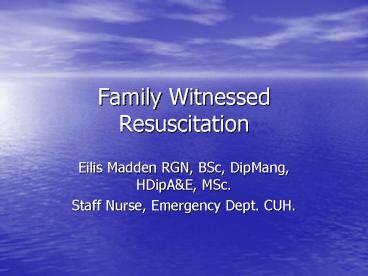Family Witnessed Resuscitation - PowerPoint PPT Presentation
1 / 12
Title:
Family Witnessed Resuscitation
Description:
Family Witnessed Resuscitation. Eilis Madden RGN, BSc, DipMang, HDipA&E, MSc. ... To Examine Emergency Nurses' Current Practices and Understanding of Family ... – PowerPoint PPT presentation
Number of Views:235
Avg rating:3.0/5.0
Title: Family Witnessed Resuscitation
1
Family Witnessed Resuscitation
- Eilis Madden RGN, BSc, DipMang, HDipAE, MSc.
- Staff Nurse, Emergency Dept. CUH.
2
Aim of the Study
- To Examine Emergency Nurses Current Practices
and Understanding of Family Presence During
Cardio-Pulmonary and Trauma Resuscitation in the
Emergency Department, Cork University Hospital.
3
Background
- Family Witnessed Resuscitation (FWR) is the
process of active medical CPR in the presence of
family members. - FWR first emerged in the 1980s and the practice
has steadily evolved due to public demand and a
growing body of research on the subject. - The literature illustrates the benefits of FWR to
patients and families however despite this data
the practice remains an ethical, moral and legal
dilemma for many healthcare professionals.
4
Literature Review
- 3 main points discussed
- Healthcare professionals perceptions of FWR.
- Families perceptions of FWR.
- Psychological Effects.
5
Objectives of the Study
- To ascertain emergency nurses preferences
regarding family presence during CPR and trauma
resuscitation. - To ascertain nurses knowledge of policies in
relation to FWR. - To identify the barriers and facilitators to
permitting family presence during CPR and trauma
resuscitation.
6
Methodology
- Quantitative descriptive design was utilised for
the study. - The sample was 100 emergency nurses with at
least six months emergency nursing experience. - A questionnaire developed by the Emergency Nurses
Association was used for data collection. - Statistical Package for Social Sciences (SPSS)
was used to analyse the data.
7
Findings
- 90 emergency nurses responded to questionnaire
resulting in response rate of 90. - 74.4 believed the unit allowed the option of FWR
for CPR and 1.2 for trauma resuscitation. - Emergency nurses often took families to the
resuscitation room (58.9 for CPR, 29.9 for
trauma resuscitation). - 74.4 would prefer a written policy allowing the
option of FWR for CPR and trauma resuscitation.
8
Findings
- The most significant barrier to FWR was conflicts
occurring within the emergency team (58.1). - The most significant facilitator to FWR was a
greater understanding of healthcare professionals
on the benefits of FWR for patients and families
(96.6).
9
Implications for Practice
- Policy development for the safe and efficient
practice of FWR with consensus of
multidisciplinary team. - Development of an educational programme on FWR.
- Further research is required on emergency
doctors opinions of FWR. - Research on relatives and patients views and
attitudes on FWR is also required.
10
Conclusion
- The findings from this research add to the body
of nursing knowledge increasing awareness on the
practice of FWR in clinical practice. - The findings also indicate the need for an
educational programme and policy development for
the practice of FWR.
11
Thank You
12
(No Transcript)































